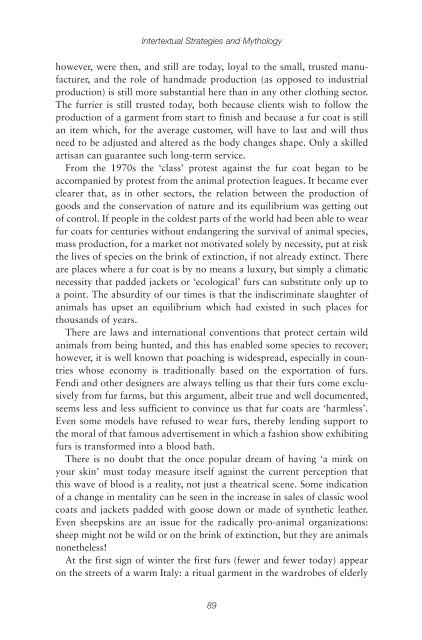Create successful ePaper yourself
Turn your PDF publications into a flip-book with our unique Google optimized e-Paper software.
Intertextual Strategies and Mythology<br />
however, were then, and still are today, loyal to the small, trusted manufacturer,<br />
and the role of handmade production (as opposed to industrial<br />
production) is still more substantial here than in any other clothing sector.<br />
<strong>The</strong> furrier is still trusted today, both because clients wish to follow the<br />
production of a garment from start to finish and because a fur coat is still<br />
an item which, for the average customer, will have to last and will thus<br />
need to be adjusted and altered as the body changes shape. Only a skilled<br />
artisan can guarantee such long-term service.<br />
From the 1970s the ‘class’ protest against the fur coat began to be<br />
accompanied by protest from the animal protection leagues. It became ever<br />
clearer that, as in other sectors, the relation between the production of<br />
goods and the conservation of nature and its equilibrium was getting out<br />
of control. If people in the coldest parts of the world had been able to wear<br />
fur coats for centuries without endangering the survival of animal species,<br />
mass production, for a market not motivated solely by necessity, put at risk<br />
the lives of species on the brink of extinction, if not already extinct. <strong>The</strong>re<br />
are places where a fur coat is by no means a luxury, but simply a climatic<br />
necessity that padded jackets or ‘ecological’ furs can substitute only up to<br />
a point. <strong>The</strong> absurdity of our times is that the indiscriminate slaughter of<br />
animals has upset an equilibrium which had existed in such places for<br />
thousands of years.<br />
<strong>The</strong>re are laws and international conventions that protect certain wild<br />
animals from being hunted, and this has enabled some species to recover;<br />
however, it is well known that poaching is widespread, especially in countries<br />
whose economy is traditionally based on the exportation of furs.<br />
Fendi and other designers are always telling us that their furs come exclusively<br />
from fur farms, but this argument, albeit true and well documented,<br />
seems less and less sufficient to convince us that fur coats are ‘harmless’.<br />
Even some models have refused to wear furs, thereby lending support to<br />
the moral of that famous advertisement in which a fashion show exhibiting<br />
furs is transformed into a blood bath.<br />
<strong>The</strong>re is no doubt that the once popular dream of having ‘a mink on<br />
your skin’ must today measure itself against the current perception that<br />
this wave of blood is a reality, not just a theatrical scene. Some indication<br />
of a change in mentality can be seen in the increase in sales of classic wool<br />
coats and jackets padded with goose down or made of synthetic leather.<br />
Even sheepskins are an issue for the radically pro-animal organizations:<br />
sheep might not be wild or on the brink of extinction, but they are animals<br />
nonetheless!<br />
At the first sign of winter the first furs (fewer and fewer today) appear<br />
on the streets of a warm Italy: a ritual garment in the wardrobes of elderly<br />
89

















